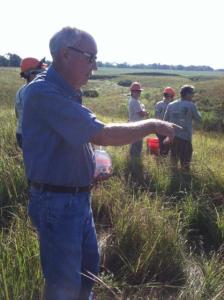~a column by Colleen O’Brien
“What had been a landscape for thousands of years is now a postage stamp.”
Conservationist Erin Van Waus said this about the Iowa prairie, or more accurately, what’s left of the Iowa prairie.
Erin works as land stewardship director for Iowa Natural Heritage Foundation, whose broad mission is to protect and restore Iowa’s land, water and wildlife. Several stewards and conservation interns and hirees are working with a longtime Greene County family, the Perkins, south and west of Jefferson on the rolling hills across the road from Seven Hills Park. Carroll Perkins has worked many years at preserving his family heritage. Recently, he donated 30 acres of it — virgin prairie — to INHF to be preserved into the far future.

This is an important and laudable action, for 30 acres is significant: this is remnant prairie, meaning it’s never felt a plow on its back. It looks like it did when the Sioux met at Council Oak and the Europeans first ventured into west central Iowa.
“I’m 88 years old,” said Carroll on a cool breezy day last week as we stood on a flower-covered hill in the sun and watched the tall prairie grass known as big bluestem bend in waves across the isolated expanse. “I was able to do this prairie till I was 85. I was making progress with the invasives. Then my knees gave out and I realized I couldn’t take care of this prairie by myself anymore. So I talked to Iowa Natural Heritage.”
For this reason, Perkins is entrusting the prairie to INHF’s ownership, accomplishing permanent protection as well as handing forward the stewardship.
The day I joined Carroll, his son Dan and the prairie keepers, they were cleaning a ravine of invasive trees and planning the long-term care of this part of our planet. “This area of the land was never able to be tiled,” Carroll said, “and we [his family] didn’t want to farm the slope. Dan Towers [Greene County conservation board] harvested prairie seed from down there . . .” – Carroll pointed across to a low hill above a creek – “and we spread it around up here.” There was one small bit of ridgetop that had been cropped in the past. Seeding was used to reconstruct prairie on that hill field and also to increase diversity in other areas, an effective sowing of diverse seed, enhancing what already grew there.
Carroll turns in a half circle, his arm sweeping across the view of his land. “In the 1950s, this was all wide open,” he said. “All these trees down there by the creek have encroached – the eastern red cedars, native but nothing grows under them and they shade out the grasses; then the other natives that in times past were controlled by lightning fires or Indians burning them off – and the honeysuckle, red elm and the non-native mulberry, they’ll go, that big cottonwood will stay.”
Part of the upkeep of prairie is to burn every other year or so to help with the spread of seed and the control of trees and bushes. “If you just leave it, that’s when the brush takes over,” said Ryan Schmidt, land stewardship assistant for Iowa Natural Heritage organizing the day’s work. “Prairies thrive off fire because it stimulates healthier and more diverse growth.”
The preservation of prairie involves much more than just saving the tall grass. “It is a habitat for bugs and animals,” said Erin. “And those trees there? When we remove a group of red cedars, maybe a hundred species lying in wait in the dirt in the shade will spring up and grow.”
Management of prairie includes grazing, mowing and brush removal as well as the periodic burn. Although prairie once grew and proliferated on its own with only a nudge now and then from nature and native peoples, it now needs help, what with so many non-native plants encroaching. The Iowa Natural Heritage Foundation is a wonder of an organization, a happy piece of non-profit agency in the midst of bad news, invasive agencies we ourselves have to deal with and a general idea promulgated by Faux News and others of that ilk that everyone in the world is if not evil at least greedy and that because of them, not much is salvable.
These folks out there on the prairie hill, starting with Greene County farmer Carroll Perkins, are happy heroes who know that with a little bit of dedication and sweat, good things happen — big bluestem and his cousins will be salvaged, strange and beautiful bugs will have a home and coneflowers will flourish. “We get to work outside,” one of the young tree removal team said. “This is an awesome opportunity, working with Carroll. We have fun. We’re doing good.”
One-tenth of one percent of virgin prairie remains in the state. According to Iowa wildlife biologist Dr. Jim Peace, 2,900 square miles of habitat loss happened in Iowa last year because of farmers removing land from conservation to crop as the price of corn went up.
Let’s hear it for a savior and his skilled and visionary helpers who are indeed “doing good” on Perkins Prairie Preserve.
